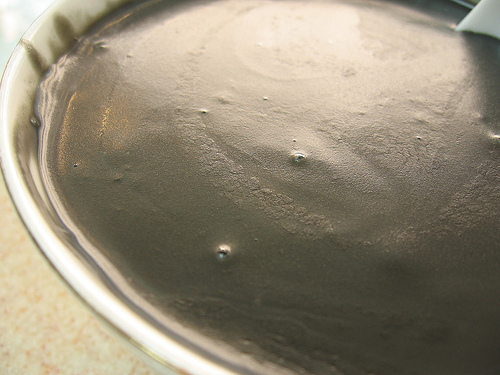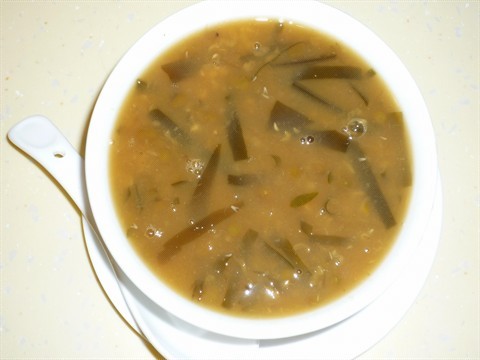Tang Shui on:
[Wikipedia]
[Google]
[Amazon]



 ''Tong sui'' (; ), also known as ''tim tong'', is a collective term for any sweet, warm
''Tong sui'' (; ), also known as ''tim tong'', is a collective term for any sweet, warm
 Tong sui shops in Hong Kong mainly originated from the postwar period. Chinese migrants brought their hometown sweet soups to Hong Kong, such as red bean soup from Guangzhou and tang yuan from Shanghai. Newcomers sold tong sui in newly opened street side food stalls and Chinese tea house.
During the 1980s to 1990s, Hong Kong's economy developed rapidly and living standards rose. Western desserts and sweet soups were imported to Hong Kong by Western hotels or cooks who had studied in the West. Under Western influence, people started using fresh fruits to create new-style tong sui such as tapioca pudding. Many Chinese herbal tea shops like Hui Lau Shan transformed into tong sui shops.
In the 21st century, chain tong sui shops have become more prominent and recommended as tourist attractions by The Hong Kong Tourism Board.
Tong sui shops in Hong Kong mainly originated from the postwar period. Chinese migrants brought their hometown sweet soups to Hong Kong, such as red bean soup from Guangzhou and tang yuan from Shanghai. Newcomers sold tong sui in newly opened street side food stalls and Chinese tea house.
During the 1980s to 1990s, Hong Kong's economy developed rapidly and living standards rose. Western desserts and sweet soups were imported to Hong Kong by Western hotels or cooks who had studied in the West. Under Western influence, people started using fresh fruits to create new-style tong sui such as tapioca pudding. Many Chinese herbal tea shops like Hui Lau Shan transformed into tong sui shops.
In the 21st century, chain tong sui shops have become more prominent and recommended as tourist attractions by The Hong Kong Tourism Board.
 Historically, the basic ingredients of traditional sweet soups are beans, milk, and fruits. The desserts and sweet soups provided in the menus of the traditional tong sui shops are mainly the Chinese-style sweet soups. Staples like red bean soup and sweet
Historically, the basic ingredients of traditional sweet soups are beans, milk, and fruits. The desserts and sweet soups provided in the menus of the traditional tong sui shops are mainly the Chinese-style sweet soups. Staples like red bean soup and sweet 新舊糖水舖 左右互搏生意經. The Sun. Retrieved 19/3/2014
/ref>
Recipe for sweet potato soup
Various Tong Sui photos on Flickr
{{DEFAULTSORT:Tong sui Cantonese words and phrases Chinese desserts Chinese soups Cantonese cuisine



 ''Tong sui'' (; ), also known as ''tim tong'', is a collective term for any sweet, warm
''Tong sui'' (; ), also known as ''tim tong'', is a collective term for any sweet, warm soup
Soup is a primarily liquid food, generally served warm or hot (but may be cool or cold), that is made by combining ingredients of meat or vegetables with stock, milk, or water. Hot soups are additionally characterized by boiling solid ing ...
or custard
Custard is a variety of culinary preparations based on sweetened milk, cheese, or cream cooked with egg or egg yolk to thicken it, and sometimes also flour, corn starch, or gelatin. Depending on the recipe, custard may vary in consistency fro ...
served as a dessert
Dessert is a course (food), course that concludes a meal. The course consists of sweet foods, such as confections, and possibly a beverage such as dessert wine and liqueur. In some parts of the world, such as much of Greece and West Africa, and ...
at the end of a meal in Cantonese cuisine
Cantonese or Guangdong cuisine, also known as Yue cuisine ( or ) is the cuisine of Guangdong province of China, particularly the provincial capital Guangzhou, and the surrounding regions in the Pearl River Delta including Hong Kong and Maca ...
. ''Tong sui'' are a Cantonese specialty and many varieties are rarely found in other regional cuisines of China. Outside of Cantonese-speaking communities, soupy desserts generally are not recognized as a distinct category, and the term ''tong sui'' is not used.
In Hong Kong, Macao and Malaysia, a large variety of tong sui is served in tong sui specialty stores. Tong sui stores have also gained prominence in overseas Chinese
Overseas Chinese () refers to people of Chinese birth or ethnicity who reside outside Mainland China, Hong Kong, Macau, and Taiwan. As of 2011, there were over 40.3 million overseas Chinese.
Terminology
() or ''Hoan-kheh'' () in Hokkien, refe ...
communities, and are found in various parts of Canada, Australia
Australia, officially the Commonwealth of Australia, is a Sovereign state, sovereign country comprising the mainland of the Australia (continent), Australian continent, the island of Tasmania, and numerous List of islands of Australia, sma ...
and the United States.
History
 Tong sui shops in Hong Kong mainly originated from the postwar period. Chinese migrants brought their hometown sweet soups to Hong Kong, such as red bean soup from Guangzhou and tang yuan from Shanghai. Newcomers sold tong sui in newly opened street side food stalls and Chinese tea house.
During the 1980s to 1990s, Hong Kong's economy developed rapidly and living standards rose. Western desserts and sweet soups were imported to Hong Kong by Western hotels or cooks who had studied in the West. Under Western influence, people started using fresh fruits to create new-style tong sui such as tapioca pudding. Many Chinese herbal tea shops like Hui Lau Shan transformed into tong sui shops.
In the 21st century, chain tong sui shops have become more prominent and recommended as tourist attractions by The Hong Kong Tourism Board.
Tong sui shops in Hong Kong mainly originated from the postwar period. Chinese migrants brought their hometown sweet soups to Hong Kong, such as red bean soup from Guangzhou and tang yuan from Shanghai. Newcomers sold tong sui in newly opened street side food stalls and Chinese tea house.
During the 1980s to 1990s, Hong Kong's economy developed rapidly and living standards rose. Western desserts and sweet soups were imported to Hong Kong by Western hotels or cooks who had studied in the West. Under Western influence, people started using fresh fruits to create new-style tong sui such as tapioca pudding. Many Chinese herbal tea shops like Hui Lau Shan transformed into tong sui shops.
In the 21st century, chain tong sui shops have become more prominent and recommended as tourist attractions by The Hong Kong Tourism Board.
Traditional tong sui
 Historically, the basic ingredients of traditional sweet soups are beans, milk, and fruits. The desserts and sweet soups provided in the menus of the traditional tong sui shops are mainly the Chinese-style sweet soups. Staples like red bean soup and sweet
Historically, the basic ingredients of traditional sweet soups are beans, milk, and fruits. The desserts and sweet soups provided in the menus of the traditional tong sui shops are mainly the Chinese-style sweet soups. Staples like red bean soup and sweet almond
The almond (''Prunus amygdalus'', syn. ''Prunus dulcis'') is a species of tree native to Iran and surrounding countries, including the Levant. The almond is also the name of the edible and widely cultivated seed of this tree. Within the genus ...
soup are common types of sweet soups sold in the ordinary tong sui shops./ref>
Common varieties
See also
* Cantonese desserts * Chè * Compote * Fruit cocktail * Kissel * Kompot * List of Chinese desserts * List of Chinese soups * List of soups * Ching bo leung * Tangyuan (food)Sources
External links
Recipe for sweet potato soup
Various Tong Sui photos on Flickr
{{DEFAULTSORT:Tong sui Cantonese words and phrases Chinese desserts Chinese soups Cantonese cuisine